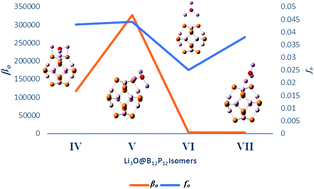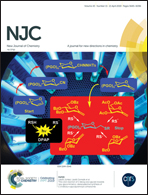Theoretical study on a boron phosphide nanocage doped with superalkalis: novel electrides having significant nonlinear optical response†
Abstract
Three series of compounds Li2F@B12P12, Li3O@B12P12 and Li4N@B12P12 are theoretically designed and investigated for their nonlinear optical response using density functional theory (DFT). Computational results reveal that isomers VIII and X are inorganic electrides whereas the others are excess electron systems. Interaction energies reveal that these systems are quite stable and superalkalis are chemisorbed on the nanocage. Doping of a B12P12 nanocage with superalkali brings a considerable increase in the first hyperpolarizability response of the system. The highest first hyperpolarizability (β0 = 3.48 × 105 a.u.) along with good ultraviolet transparency is observed for isomer III of Li2F@B12P12. Moreover, all three series of compounds are systemically studied for the effect of different superalkalis and different doping positions on the nonlinear optical response. This study will be advantageous for promoting the potential applications of the fullerene-like superalkali doped B12P12 nanostructures in new types of electronic nanodevices and high-performance nonlinear optical materials with good ultraviolet transparency.



 Please wait while we load your content...
Please wait while we load your content...